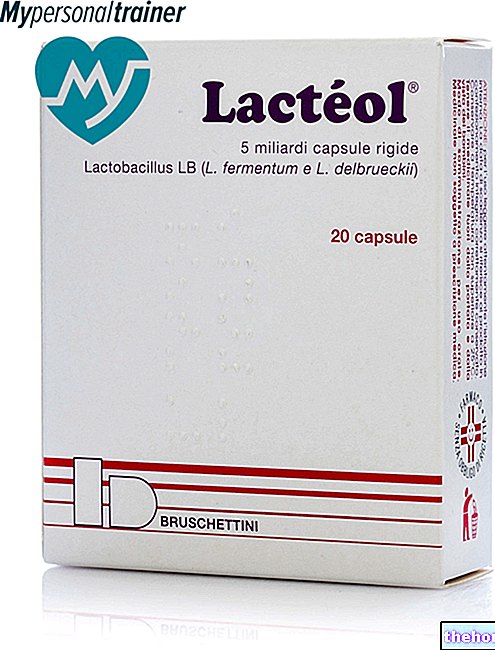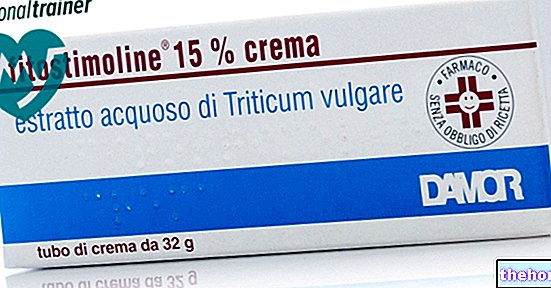Active ingredients: Mesalazine
PROCTASACOL 500mg - Rectal gel
Why is Proctasacol used? What is it for?
PROCTASACOL contains the active substance mesalazine, belonging to the category of intestinal anti-inflammatory medicines.
This medicine is used in adults and children over 2 years of age for the treatment of certain chronic inflammatory bowel diseases (ulcerative proctitis and Crohn's disease) and other acute or chronic inflammations (idiopathic inflammation) localized in the terminal part of the " intestine or in the perianal area.
The medicine is indicated both in the treatment of the active phases of the disease and in the prevention of relapses.
In severe cases of bowel inflammation, your doctor may also prescribe treatment with corticosteroids (cortisone).
Talk to your doctor if you do not feel better or if you feel worse after the prescribed treatment period.
Contraindications When Proctasacol should not be used
Do not use PROCTASACOL
- If you are allergic to mesalamine other related medicines (such as salicylates), or to any of the other ingredients of this medicine.
- If you suffer from severe impairment of kidney function (kidney failure).
- If you have severe kidney problems (severe nephropathy), damage to the inner lining, mucosa, stomach or intestines (stomach or duodenal ulcer).
- If you have a predisposition to developing bleeding.
- In children under 2 years of age (see "Children" section).
- In the last weeks of pregnancy and during breastfeeding. During the other stages of pregnancy, your doctor will carefully consider the need for treatment with this medicine (see section "Pregnancy and breastfeeding").
Precautions for use What you need to know before taking Proctasacol
Talk to your doctor or pharmacist before using PROCTASACOL.
Before starting treatment with PROCTASACOL, you will need to undergo the necessary clinical investigations to define the diagnosis and therapeutic indications.
Use the medicine with caution if you have reduced kidney and liver (liver) function.
The doctor will carefully evaluate the renal function for all patients before starting therapy, and periodically during treatment, especially in the presence of previous kidney disease.
After discontinuation of treatment and during inadequate maintenance treatment, symptoms of the disease may reappear.
In severe cases of bowel inflammation, your doctor may also prescribe treatment with corticosteroids (cortisone) (see section "Other medicines and PROCTASACOL").
Prolonged use of the drug can give rise to sensitization phenomena (exaggerated reactivity).
If you experience allergic reactions, stop the treatment and contact your doctor immediately (see section 4 "Possible side effects"). In severe cases of bowel inflammation, your doctor may also prescribe a corticosteroid (cortisone) treatment together with PROCTASACOL.
Children
PROCTASACOL is contraindicated in children less than 2 years of age (see section "Do not use PROCTASACOL"). The medicine is not recommended for use in children over 2 years of age, unless your doctor deems it strictly necessary.
Interactions Which drugs or foods can modify the effect of Proctasacol
Tell your doctor or pharmacist if you are taking, have recently taken or might take any other medicines.
Use the medicine with caution together with:
- Sulfonylureas (used for the treatment of diabetes) whose hypoglycemic effect (reduction of the level of sugar in the blood) can be enhanced.
- Coumarin drugs (used to slow or inhibit the blood clotting process).
- Methotrexate (medicine used in people with psoriasis, Crohn's disease, rheumatoid arthritis and in the treatment of some cancers).
- Probenecid (medicine used to decrease the concentration of uric acid in the blood).
- Sulfinpyrazone (medicine used to prevent a heart attack).
- Spironolactone (potassium-sparing diuretic)).
- Furosemide (diuretic medicine, which increases urine production, used in case of fluid retention).
- Rifampicin (antibiotic).
The use of PROCTASACOL together with corticosteroids may potentiate the unwanted effects of the latter on the stomach.
Warnings It is important to know that:
Pregnancy and breastfeeding
If you are pregnant or breast-feeding, think you may be pregnant or are planning to have a baby, ask your doctor or pharmacist for advice before using this medicine.
If you are pregnant or suspected of being pregnant, take the medicine only when clearly needed and under strict medical supervision.
Do not use PROCTASACOL in the last weeks of pregnancy and during breastfeeding (see section "Do not use PROCTASACOL").
Driving and using machines
PROCTASACOL has no or negligible influence on the ability to drive and use machines.
PROCTASACOL contains methyl p-hydroxybenzoate and propyl p-hydroxybenzoate which can cause allergic reactions (including delayed).
PROCTASACOL contains glycerol which may have a mild laxative effect.
Dose, Method and Time of Administration How to use Proctasacol: Posology
Always use this medicine exactly as your doctor or pharmacist has told you. If in doubt, consult your doctor or pharmacist.
Your doctor will decide the right dose for you based on the extent and severity of the disease.
The average recommended daily dose in adults during the active phase of the disease is 1.5 g of mesalazine, equal to 3 single-dose containers of gel.
Use in children and adolescents
Children over 2 years: the dose will be proportionally reduced in the judgment of the doctor.
Before using PROCTASACOL it is advisable to try to evacuate, to have the intestinal canal free from faeces. For the application, please follow the instructions below:
- Release the rectal cannula from the cannula cover (security seal).
- Introduce the cannula along its entire length into the anus.
- Press on the bottom of the tube to let the gel flow out.
- Smear around the perianal area (around the anus).
The duration of treatment, in the active phase, is 4-6 weeks.
In long-term treatments to prevent relapses, the daily dosage and duration of treatment should be established by the physician according to the patient's condition or the evolution of the disease.
If you forget to take PROCTASACOL
Do not use a double dose to make up for a forgotten dose, but resume your normal dosage as directed.
If you stop taking PROCTASACOL
Symptoms may come back after stopping treatment. (see section "Warnings and precautions").
If you have any further questions on the use of this medicine, ask your doctor or pharmacist.
Overdose What to do if you have taken too much Proctasacol
Following the intake of an excessive dose of the drug, by rectal administration, no particular consequences are known.
Side Effects What are the side effects of Proctasacol
Like all medicines, this medicine can cause side effects, although not everybody gets them.
With the use of PROCTASACOL, the following undesirable effects have been reported:
- Acute intolerance syndrome, characterized by cramps, abdominal pain, blood in the liquid stools (bloody diarrhea) and, occasionally, fever, headache, itching and rash, which requires discontinuation of treatment.
- Allergic reactions (for example skin reactions, itching); in this case, stop the treatment immediately (see section "Warnings and precautions") and contact your doctor immediately.
- Gastrointestinal disorders such as: nausea, pain in the upper abdomen (epigastralgia), diarrhea and abdominal pain.
- Headache (headache).
- Decrease in the number of white blood cells in the blood (leukopenia, neutropenia), decrease in the number of platelets in the blood (thrombocytopenia).
- Inflammation of the pancreas (pancreatitis), inflammation of the liver (hepatitis), inflammation of the kidneys (interstitial nephritis), kidney disease (nephrotic syndrome) and decreased kidney function (kidney failure).
Reporting of side effects
If you get any side effects, talk to your doctor or pharmacist. This includes any possible side effects not listed in this leaflet. You can also report side effects directly via the national reporting system at: www.agenziafarmaco.it/it/responsabili. By reporting side effects you can help provide more information on the safety of this medicine.
Expiry and Retention
Keep this medicine out of the sight and reach of children.
Do not use this medicine after the expiry date which is stated on the package. The expiry date refers to the last day of that month and to the product in intact packaging, correctly stored.
Avoid direct exposure to light and heat sources.
Do not throw any medicines via wastewater or household waste. Ask your pharmacist how to throw away medicines you no longer use. This will help protect the environment.
Other information
What PROCTASACOL contains
- The active ingredient is mesalamine (5-aminosalicylic acid or 5-ASA). One single-dose container contains 500 mg of mesalamine.
- The other ingredients are: Glycerin, Triethanolamine, Carboxypolymethylene, Methyl p-hydroxybenzoate, Propyl p-hydroxybenzoate, Purified water.
PROCTASACOL looks like and contents of the pack
PROCTASACOL comes as a rectal gel and is available in packs of 20 single-dose 500 mg containers with a capped, cannulated tube container for rectal administration.
Source Package Leaflet: AIFA (Italian Medicines Agency). Content published in January 2016. The information present may not be up-to-date.
To have access to the most up-to-date version, it is advisable to access the AIFA (Italian Medicines Agency) website. Disclaimer and useful information.
01.0 NAME OF THE MEDICINAL PRODUCT
PROCTASACOL 500 MG RECTAL GEL
02.0 QUALITATIVE AND QUANTITATIVE COMPOSITION
One single-dose container contains: mesalamine (5-aminosalicylic acid, 5-ASA) 500 mg.
Excipients with known effects: methyl p-hydroxybenzoate and propyl p-hydroxybenzoate, glycerol.
For the full list of excipients, see section 6.1.
03.0 PHARMACEUTICAL FORM
Rectal gel.
04.0 CLINICAL INFORMATION
04.1 Therapeutic indications
Ulcerative proctitis, Crohn's disease, acute and chronic intestinal idiopathic inflammation of anorectal and perianal localization. Treatment of active phases and prevention of relapses.
In the severe active phase it is advisable to combine it with cortisone treatment.
04.2 Posology and method of administration
Dosage
Adults
In the active phase of the disease, the average daily dose for adults is 1.5 g of mesalazine, equal to 3 single-dose containers of gel, unless otherwise judged by the doctor.
Pediatric population
For children over two years of age the doses are proportionally reduced, according to medical prescription.
There is little experience and only limited documentation on the effects in children.
The duration of treatment, in the active phase, is 4-6 weeks.
During remission, which requires long-term maintenance care to prevent recurrence, the frequency and dosage will be determined by the physician.
Method of administration
The medicine should be applied with the alvo free from faeces.
For the application, follow the instructions below:
1- Free the rectal cannula from the cannula cover (security seal).
2- Introduce the cannula into the anus along its entire length.
3- Press on the bottom of the tube to let the gel flow out.
4- Spread around the perianal area.
04.3 Contraindications
Hypersensitivity to components or other closely related substances from a chemical point of view; in particular towards salicylates.
Patients with overt renal insufficiency. Severe nephropathies. Pre-existing gastric or duodenal ulcers. The product should not be administered to patients with bleeding diathesis.
Children under the age of two.
Generally contraindicated in pregnancy; contraindicated in the last weeks of gestation and during lactation (see section 4.6).
04.4 Special warnings and appropriate precautions for use
Relapses of objective and subjective symptoms can occur both after discontinuation of treatment and during inadequate maintenance treatment.
In patients with impaired renal and hepatic function the product should be used with caution due to its kinetic and metabolic characteristics. Renal function should be closely monitored during treatment, especially in patients with previous kidney disease. Instead, its use will be avoided in those with overt renal insufficiency.
Before starting treatment, the patient must undergo the necessary clinical investigations to clarify the diagnosis and therapeutic indications.
In patients being treated with oral hypoglycemic agents, diuretics, coumarins and corticosteroids, the product should be used with caution.
In pediatrics, the drug should be administered only in case of real need and under medical supervision.
Prolonged use of the product can give rise to sensitization phenomena.
The possible occurrence of hypersensitivity reactions involves the immediate interruption of treatment.
In severe active phases, it may be advisable to associate a systemic cortisone treatment.
The medicine contains para-hydroxy benzoates, which can cause allergic reactions usually of the delayed type, and glycerol, which can have a mild laxative effect.
04.5 Interactions with other medicinal products and other forms of interaction
The hypoglycemic effect of sulfonylureas can be enhanced.
Interactions with coumarins, methotrexate, probenecid, sulfinpyrazone, spironolactone, furosemide, and rifampicin cannot be excluded.
Potentiation of undesirable effects of gastric corticosteroids is possible.
04.6 Pregnancy and breastfeeding
In case of confirmed or presumed pregnancy, administer only in case of real need and under strict medical supervision. However, the use of the product should be avoided in the last weeks of pregnancy and during breastfeeding.
04.7 Effects on ability to drive and use machines
The drug does not reduce concentration or cause drowsiness in patients under treatment.
04.8 Undesirable effects
Gastrointestinal disturbances (nausea, epigastralgia, diarrhea and abdominal pain) and headache have been reported.
The product may rarely be associated with an acute intolerance syndrome characterized by cramps, abdominal pain, bloody diarrhea and, occasionally, fever, headache, itching and rash, requiring discontinuation of treatment.
There are also reports of leukopenia, neutropenia, thrombocytopenia, pancreatins, hepatitis, interstitial nephritis, nephrotic syndrome and renal failure.
Hypersensitivity reactions (eg skin reactions, fever) may occur rarely; in this case the treatment must be stopped immediately.
04.9 Overdose
Cases of overdose following rectal administration are not conceivable.
05.0 PHARMACOLOGICAL PROPERTIES
05.1 Pharmacodynamic properties
Pharmacotherapeutic group: intestinal non-steroidal anti-inflammatory drugs.
ATC code: A07EC02.
5-aminosalicylic acid (5-ASA or mesalazine), active ingredient of PROCTASACOL, is the active fraction of salicylazosulfapyridine, a drug of consolidated use in these clinical forms.
5-ASA has a topical anti-inflammatory effect on the tracts of the intestinal mucosa affected by the lesions. Its presence in the intestinal lumen inhibits the biosynthesis of arachidonic acid derivatives (prostaglandin E2, leukotrienes) whose levels in the rectal mucosa of subjects with ulcerative colitis in the exacerbation phase are higher than normal.
The lack of the sulfapyridine fraction, to which the undesirable effects of salicylazosulfapyridine are attributed, explains how 5-ASA may be more tolerated than salicylazosulfapyridine.
The 5-ASA contained in the tablets is released at the level of the terminal ileum and colon, ensuring the topical anti-inflammatory effect on the lesions located along this tract.
The pharmaceutical form enema determines a prompt and effective local anti-inflammatory effect on the lesions located along the terminal tract of the intestine.
05.2 Pharmacokinetic properties
The pharmaceutical form coated tablets has the characteristic of disintegrating the coating at a pH higher than 6: this characteristic allows the tablet to cross the stomach intact and to make the active ingredient available in correspondence with the terminal ileum and colon where it exerts its action at topical level. The absorption of 5-ASA is modest: the substance is almost totally eliminated in the faeces.
5-ASA administered by rectal enema has a very poor systemic absorption and exerts its action locally.
05.3 Preclinical safety data
The LD50 after oral administration are:
male mouse = 1287 mg / kg; male rat = 4496 mg / kg; female mouse = 1052 mg / kg; female rat = 2071 mg / kg
The LD50 after intravenous administration are:
mouse> 3000 mg / kg; rat> 2000 mg / Kg.
The following chronic oral treatments are well tolerated:
rat at the dose of 200 mg / kg / day; dog at a dose of 120 mg / kg / day
5-ASA does not exhibit mutagenic activity.
06.0 PHARMACEUTICAL INFORMATION
06.1 Excipients
Glycerin, triethanolamine, carboxypolymethylene, methyl p-hydroxybenzoate, propyl p-hydroxybenzoate, purified water.
06.2 Incompatibility
None.
06.3 Period of validity
2 years.
06.4 Special precautions for storage
Avoid direct exposure to light and heat sources.
06.5 Nature of the immediate packaging and contents of the package
Single-dose tube container, in white-opaque low density polyethylene, with cap and cannula of the same material for rectal administration.
Pack of 20 single-dose containers of 500 mg.
06.6 Instructions for use and handling
No special instructions for disposal.
Unused medicine and wastes derived from this medicine must be disposed of in accordance with local regulations.
07.0 MARKETING AUTHORIZATION HOLDER
GIULIANI S.p.A. via Palagi 2, 20129 Milan
08.0 MARKETING AUTHORIZATION NUMBER
PROCTASACOL 500 mg rectal gel - 20 single-dose containers
AIC n. 035509013
09.0 DATE OF FIRST AUTHORIZATION OR RENEWAL OF THE AUTHORIZATION
Date of first authorization: 17 September 2004
Date of most recent renewal: March 2009
10.0 DATE OF REVISION OF THE TEXT
11 June 2016




























